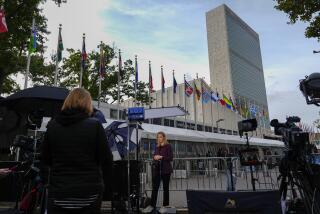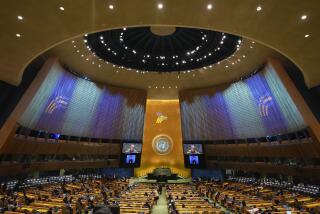Rhetoric, but Few Solutions to Ending Worldwide Poverty
WASHINGTON — World finance leaders wrapped up their fall meetings Sunday with bold, rhetorical promises to make globalization work for the poor, but with few new resources to ensure that the job gets done.
Instead of launching big poverty-reduction initiatives or substantially expanding existing ones, members of the World Bank and the International Monetary Fund endorsed more modest changes, tweaking here and there. They cited the need to honor ambitious commitments already on their agendas.
“The era of promises must be replaced by the era of implementation,” declared Gordon Brown, British chancellor of the Exchequer.
The most dramatic departure was a decision to consider creating a bankruptcy tribunal for insolvent governments. But that would address sudden financial crises in middle-income countries such as Brazil or Argentina, not the chronic, intractable poverty of sub-Saharan Africa.
The United States and other wealthy nations promised to pay an additional $1 billion into a trust fund for Third World debt relief. But they were following through on a previous pledge and did not consider proposals that would have expanded the program to provide greater debt reduction.
“Despite a lot of goodwill and the right rhetoric, the donor community has not found a way to come up with the resources to put countries that are very poor but well-managed back on track,” said Nancy Birdsall, president of the Center for Global Development, a public policy organization in Washington that deals with issues of world poverty and inequality.
Instead of focusing their energy on the largely ceremonial gatherings of the IMF and the World Bank, globalization protesters “should hold them accountable after the meetings for what they’ve said they would do,” Birdsall said.
If words could do the job, the work would be half done. One after another, representatives of the 184 member nations of the IMF and the World Bank stepped up to the lectern at Sunday’s concluding session and endorsed the need to harness the forces of globalization to serve the interests of the world’s least-developed countries.
“Should the rich become richer and the poor poorer as a result of globalization, the resulting unfairness must be addressed,” said Dai Xianglong, head of the People’s Bank of China.
World Bank President James D. Wolfensohn said old dichotomies disappeared after last year’s terrorist attacks.
“There are not two worlds, rich and poor; there is only one,” Wolfensohn said. “We are linked by finance, trade, migration, communication, environment, communicable disease, crime, drugs and certainly by terror. More and more people are saying poverty anywhere is poverty everywhere, and their voices are getting louder.”
IMF and World Bank officials cited the $1-billion debt-relief pledge as evidence of the shared commitment to helping the world’s poor. But they acknowledged that it was a reaffirmation of past pledges by wealthy nations, not a significant expansion of the program launched six years ago to reduce the big debt payments that consume resources that would be better spent on health and education in poor countries.
Officials said proposals to expand the program have been opposed by members of the Group of 8 industrialized nations, particularly the United States and Britain, because of concerns that the money might be misspent in countries where corruption has been a problem.
A number of mainstream advocacy groups and development scholars have concluded that the debt-relief program should be expanded. Only six countries have completed the program, which does not eliminate debt, but reduces it to “sustainable” levels based on estimates of economic growth, commodity prices and other factors. Some of those countries are having problems making their reduced payments because of depressed commodity prices.
“Everybody was pushing debt on them 20 years ago,” said Peter Morici, a business professor at the University of Maryland and a former U.S. trade official. “For the poorest of the poor, if we can just wipe it out and give them a chance to start over, it’s not a lot of money in the grand scheme of things.”
Morici and other authorities said the proposal to establish a bankruptcy process for countries with big sovereign debt obligations represents a more substantial policy initiative.
Finance officials directed the IMF staff to spend six months developing a detailed plan for setting up an arbitration process to restructure the debts of insolvent countries such as Argentina, which has defaulted on its foreign debt.
The directive is surprising in part because it had been opposed by big banks and other creditors that might recover less of their money by participating in a restructuring process than by suing in court. Until recently, the Bush administration showed little enthusiasm for the idea.
The decision to move forward on the proposal was even characterized as a sign of slight progress by one of the organizers of the previous day’s anti-globalization protests outside the IMF and World Bank buildings.
“We have demanded that there be a procedure for declaring these debts illegitimate,” said Soren Ambrose, policy analyst for 50 Years Is Enough, a Washington-based coalition of groups advocating change in the two financial institutions. “This is not quite that. But it is an acknowledgment that this problem exists, and that we have to come to a more definitive solution of the debt.”
In most other respects, the fall meetings of the two institutions appeared to break little new ground or address trouble spots such as Brazil’s collapsing currency or Japan’s economic paralysis.
“There was really no change in terms of the management of the world economy, including how to handle the immediate crisis in Brazil. I don’t get the sense that anybody is happier with Japan than they were before, or less worried about what would happen if there’s a war with Iraq,” said John Williamson, a senior fellow at the Institute for International Economics and a former World Bank economist. “There usually isn’t an enormous amount decided at these meetings, so I would say this is about par for the course.”
More to Read
Sign up for Essential California
The most important California stories and recommendations in your inbox every morning.
You may occasionally receive promotional content from the Los Angeles Times.










